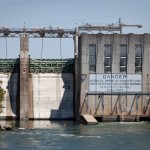A View From the Tipping Point: The ‘Switch’ for Energy’s Future
It’s a heavy question: Where is all of our energy going to come from? That puzzle is at the center of a new film and education project, ‘Switch,’ featuring Scott Tinker, Director of the Bureau of Economic Geology at the University of Texas at Austin.
“The world’s population just passed seven billion,” Tinker said at a presentation on the film earlier this year. “And we’re adding a billion people every thirteen years.” As that population grows, energy demands grow with it. While developed nations’ energy use will flatten, Tinker said more and more countries are industrializing, which means more power demands. “There are several billion people just getting access to energy for the first time.”
So where’s all that energy waiting? In the film and presentation, Tinker looks at all of the options: coal, oil, natural gas and renewables. Let’s start with coal. “Coal is available, affordable and reliable,” Tinker said. “But it’s also dirty.”
Coal means mining impacts, water demands and the release of particulate matter, carbon dioxide and mercury. But for much of the developing world, Tinker said, coal will be their main source of power. Despite shrinking demand for coal in the U.S., it’s the opposite situation in the developing world.
For the film, Tinker traveled to India, where there are 600 million people without electricity today — double the population of the U.S. And as the country continues to develop, they’re going to want and need more electricity. “And that’s going to be coal,” Tinker said. The energy demands of China and India are expected to exceed those of the U.S. and Europe combined.
Black Gold
While there is plenty of oil left in the world, it will take unconventional drilling to get at most of it. Place like the tar sands in Canada can produce massive amounts of oil, but at greater financial and environmental cost.
“It’s ugly,” Tinker said. But he visited drilling sites in the process of remediation, where topsoil has been put back on the pad and replanted. “In twenty years you won’t know that it was there.” And fracking has put domestic deposits of oil on the menu as well. “We’re heading towards a million barrels a day. That’s what we import from Saudi Arabia.”
The challenge of oil goes beyond the environmental impact, according to Tinker. “It’s held tightly geographically, has an environmental impact with its CO2 emissions, and the perception of the oil industry in the U.S. and Europe isn’t good. The rest of the world loves it, though.”
Tinker said the other problem with oil is consumption. “We don’t store oil very well. Our strategic petroleum reserve is not particularly strategic, and not much of a reserve. We consume what we produce.”
In his presentation, Tinker pointed out that just six years ago, car sales in China were a third of what they are in the U.S. Now they have nearly quadrupled, and car sales in China are almost double what they are here.
“Twenty four hours a day, seven days a week, we’re consuming a tanker of oil every thirteen minutes,” Tinker said. “That should give you a weird feeling in your guy about consumption. But don’t blame oil.”
Gassing Up
“Fracking” has become a commonplace term in the last few years as the natural gas boom took drilling to more and more corners of the country. “There’s more production and reserves of natural gas than we’ve ever had before,” said Tinker. In the Barnett Shale outside of Fort Worth there are some 16,000 wells alone. There’s even a drilling pad right underneath the University of Texas at Arlington.
“The surface disruption is getting much smaller,” Tinker said. “And you can now drill several lateral [wells] from one pad,” reducing the impact above ground.
And shale gas exploration isn’t just happening in the states. A massive shale has been discovered in the Siberian basin, along with others in Australia, South America, Europe and China.
One common concern about fracking — whether for oil or gas — is how much water is used. A typical “frack job” needs one to five million gallons of water. “But relatively, it really doesn’t use a lot of water,” Tinker said. “Overall it’s about the same amount used to water the golf courses in Texas.” And water for mining pales in comparison to the amounts need for irrigated agriculture.
The downsides of natural gas? There’s the traffic, noise, water and land use, carbon emissions and light pollution that all take place during drilling, Tinker said. But he believes the gas boom is good overall. “It greatly improves our energy security and efficiency. But we need to balance industrial activity with safety and the environment. It can be done.”
Nuking Down
Did Fukushima destroy nuclear power development? Tinker thinks the damage was mostly to the perception of nuclear power. “There were no radiation deaths from Fukushima,” he said, “and there’s not really many deaths from nuclear disasters in history. The one exception is Chernobyl. Radiation just scares people.” (A new study from Stanford, however, has found that there could be as many at 13,000 deaths in the long-run related to the accident.)
In the film, Tinker visits France, home to the largest nuclear reprocessing facility in the the world. He finds three large pools that cool depleted uranium from spent nuclear reactor fuel rods, before the rods are reclaimed. 95 percent of the uranium is re-enriched and then sent back to the reactors. One percent of what’s left is plutonium, which they also use for power, and the remaining four percent gets stored. “That’s unbelievable,” he said. “There’s not much solid waste from that process.”
It’s Not Easy Being Green
There’s a wide range of renewable options out there, Tinker said, from biofuels to fuel cell technology, but there’s no magic solution as of yet. “This is the world you have to deal with going forward,” he said. “The realistic world. We base our decisions on power largely around price.” And for now, green power requires the most greenbacks.
Where does he see hope for renewable power? In sectors like geothermal energy. He visited a geothermal hotspot in Iceland that is reminiscent of Yellowstone. “They’re using oil well technology to steam water at the surface, and take that steam down a pipeline to the cleanest power plant we’ve ever been to in the world. There’s no chemicals in there.”
The problem is finding those hot spots. They’re in California, and parts of Southeast Asia, but Texas and most of the rest of the world don’t have the same geothermal activity.
And what of the sun? Tinker sees hope there, too. He visits industrial solar farms in Spain, with giant mirrors. “They focus the sun’s light on a tower, use that heat to boil water, which then makes steam and turns a turbine,” he said. But scale and investment is a big challenge. “In times of recession we don’t invest that much in things that make environmental sense. We can’t afford to.”
Then there’s intermittent nature of solar power, as well as wind. “It sounds trite, but it’s a very important thing. The sun doesn’t always shine and the wind doesn’t always blow.”
The wind in the panhandle of Texas typically kicks in at night during the peak demand days of August. But it’s most needed during the hot afternoons. If there were a way to store that energy at night, wind could be an even bigger part of Texas’ energy mix. “If we can crack the nut of electricity storage,” Tinker said, “the whole world changes.”
Looking to the Future With One Eye Open
Listening to Tinker talk about the future of energy is a lot like a Sunday sermon: you feel hopeful and doomed all at once. On the hopeful side, he said that soon the U.S. will be a minor player in carbon emissions. On the doom side, those reductions will be more than made up for by growing countries. “Coal will power the development of China and India, but it won’t be clean,” Tinker said. “Oil demand will increase, and so will risk. And so will price.”
So it comes down to this: How do you maintain benefits of coal and oil without the disadvantages at a price we can all afford? Can it be done?
The answer is a qualified yes. “Close to 60 percent of our energy produced is wasted,” Tinker said, “heat going out of stacks, out of cars.” With greater energy efficiency on the production side, we wouldn’t even have to change our lifestyle.
And renewables could grow. By 2080, it is projected that renewables will be on par with oil consumption and coal, and close to natural gas. “Oil and coal are very tough to replace,” Tinker said. “Renewables are a good regional supplement, but they will remain just that until we can make big gains in energy storage.”
Tinker said that supply transitions in energy can take decades. But he also believes that individual behavior matters. And that energy security is good policy for the U.S., and the world. In a growing and warming world, he believes that what could save us is what has always saved mankind up until this point: we will have to get smarter.
You can learn more about the Switch Energy Project at their website.

